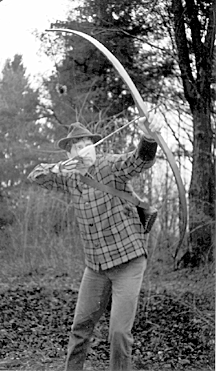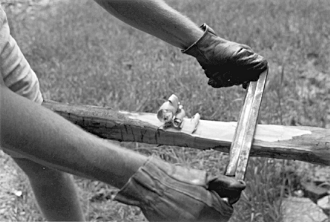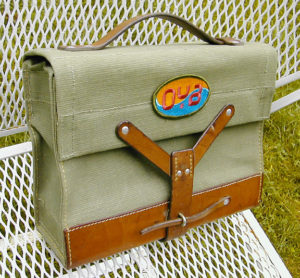Whitling A Longbow
by Jeff Potter
I grew up reading archery books and making goofy backyard bows. So it sounds inevitable, but in fact it took decades until I stumbled on my chance to make my own serious archery bow. But the first chance I had, I grabbed it. Serendipity waits for no man.
I had showed Craig, my father-in-law, this pretty new book I bought, The Traditional Bowyer’s Bible (Vol. 1). The cover was so pretty I just propped it up and looked at it while I worked overtime publishing tech manuals all summer.
Craig said “Hey, I was just in my Dad’s basement yesterday and I came across a bunch of bow staves…just like in your book. Do you want one?”
I about had a fit. Within a week, I had a heavy, black old log leaning next to me while I worked at the computer, cranking out books. I’d often look at it and wonder.
Where does the love for a bow come from? It must be because curved limbs and arcing projectiles embody both beauty and power. Not just for guys, either! During the past few summers at our rustic estate, one of the favorite pastimes for guys and gals alike has been to get out all my old bows and archery targets and lob arrows at hay bales in the back yard. I showed them the basics, but each has their own style. (Lindy shoots like a hero from the classical mythology of India.)
After the building of the yurt, though, and with the advent of our quasi-country lifestyle, I’ve had a yearning to be a Provider and Creator. You know, til the soil, chop wood, fix my own garage. Maybe it’s our fiscal restraints, too. I just have these fantasies where I make the stuff I need or want instead of shelling out the big bucks. I’m thinking that almost nothing is as hard as you’re lead to believe. We’ve planted fruit trees and I’ve started taking out hunting and fishing licenses again. I’d shot my first buck with a rifle last year and appreciated the meat. I thought a homemade bow would be quieter, more natural and cheaper.
Thus primed, I wanted to make a “self” longbow, that is, one hewn from a singe piece of wood. Bow types also include laminated longbows (lighter, faster, easy to mass produce), recurves (with curved limbs for more speed in a shorter bow), or compound bows (high-tech factory bows using pulleys and cable-clumsy, but superfast). Compounds were invented in the 70’s, and they’ve taken over the market. In the last ten years, though, traditional gear has made a big comeback. It’s mainly a reaction to too much tech. And one big help is that custom traditional bows don’t cost much more than compounds. Numbers of traditional bowmakers have gone from 5 to 400 in the last ten years, with saturation not reached.
I finally finished my biggest book of the summer, after weeks of 16 hour days. I was wasted from the book, but didn’t go to bed. After dinner that night, I went to the basement, as in a trance, stave in hand.
I looked at the 30-pound log and my circular saw. It wouldn’t adjust deep enough. Then I got my old boyhood hatchet, sharpened it and put on gloves and started whacking. I had to hit that wood hard to even get a shaving. It almost sparked. Osage Orange is one of the hardest woods. Off came the drenched shirt. Until midnight I chopped. I couldn’t quit until I’d kinda got it shaped out. It felt so good shaping that wood, so different from typing! It smelled great, too.
In bowmaking, you have to follow the grain of the wood wherever it goes, and Osage is the most gnarly of bow woods. The bowyer is not the boss. The wood is. It’s amazing watching the bow come out of the wood. I just follow, hope, and wail away. I finally collapse, neither hand able to grasp the hatchet. I had a mountain of huge flakes around me. And beheld a long, tapering, slightly irregular pole of gold.
The next day I showed it off. “This used to be a huge log!” I told my friends. Wow, some said. Many others, even carpenters, said What is it? I was overall a little crestfallen. “It’s a bow!” But in truth, it was still a log. I showed them the Bowyers Bible and the beautiful photo and pointed to my log. Some slapped me on the back and laughed.
The next 2 days I worked it hard. Now with draw-knife. I tied it to the porch and whacked away. People inside told me to quit, I was knocking things off the walls. I tied it to a tree and carved away. Sweat poured. Trying to find that one growth ring that would form the back of the bow. Groping. Then getting bold again. In the middle of the night, I bent it on the special rig described in the Bible. It made the bow shape. Yes, I thought.
The Bible says that you’re supposed to make your first bows “without hope but with persistence.” Just one little gouge through the growth ring and the show’s over…
I refused to move on until each imperfection was reduced to smoothness. The thing was now scarily slender. Where was my log? I sanded and sanded. Only this golden feather was left. I varnished it three times. Not ready yet. I stitched up a leather handle. Not yet. I added nice beads. Done. It pulled 55 pounds. Perfect.
I shot it. It was too stout for me at first. I shot all over the place. A month later I was grouping all shots into the area of a paper plate, which is as good as any archer needs for hunting and casual target archery. It still doesn’t have a name. But it shoots smooth and soft. And it was free. Hacked from wood in 30 hours. -In the shop they cost $300-450.
I showed my finished creation around. People couldn’t believe it was the same old log. “Where’d you buy this?” “Wow!”
My mountain man friend budged a bit from his usual taciturn self and told me it looked pretty good. (I know we’re not near mountains, but what else do you call a huge, barrel-chested, bearded guy who hunts a lot with primitive gear?) I looked around his shop with new appreciation at all the workmanship in the “self” bows. I’d previously been attracted only to the ‘regular’ bows made with laminations. I now had an eye for ‘snaky’ bows. Osage is the most difficult bow wood, but one of the best in the end. If you can follow its snaking grain, you will have a fine bow. Some of these bows, the “character” bows, have wild deviations in their limbs. Some have knots in the limb-center where the bowyer left extra wood on either side…and knocked out the knot! Some were backed with rattlesnake hide to prevent splintering and breaking. Indians used sinew.
So, now that shooting feels just right, bending the stout, intense limbs, plowing my gloved string-hand back to that sweet spot at the corner of my mouth, feathers of the knocked arrow scratching at my cheek, now that I can plug that shred of a paper plate on my bales in the snow and falling light, I want to go out and shoot a deer. Log bow goes back to woods. To put the free, tasty meat in heavy stacks into our freezer. I’ll butcher it myself. Indeed, I did get in a few weeks hunting around Christmas. I found sitting at my perfect spot to be quite mesmerizing, and more relaxing compared to all my action-packed outdoor sports. I even had one chance to get a deer. After days of nothing, I heard crashing behind me and hoofbeats. Three deer ran past. I whistled. One fat doe stopped 20 feet away. She walked slowly in the freezing, snowy, almost-dark. I had the bow pulled halfway. I could’ve easily shot, but waited for her to stop. She didn’t and bounded away. Oh well. There’s always gardening in the spring.
Archery Culture
My special archery feelings grew naturally from our woodsy family roots. But people who can’t see the point might someday want to pick up a copy of Saxon Pope’s Hunting with the Bow and Arrow, a book about the adventures and friends of one of the first Euro-Americans to learn Native American bow hunting. Or Kroeber’s classic Ishi-in Two Worlds, about one of the last wild Indians and the Ways he taught his curator benefactors. Or Howard Hill’s Hunting the Hard Way…
Hill was the best archer ever. And he was full of style, humility and panache. He was the stuntman for many Hollywood archery scenes, including all the stunts in Errol Flynn’s Robin Hood. No lame Costner-era computers, those were all real shots…including a climactic shot from a balcony down to a letter lying on a table between the hands of Flynn, Rathbone and Rains…the arrow had a huge razor broadhead on it! In cowboy movies, he really knocked those riders off their horses. They only had wood boards over their chests and back to stop his arrows from killing them. I read all Hill’s books. The only time my Mom remembers me getting upset as a youth was in the supermarket when I came up to her shaken and said “Mom!” She became afraid and asked “What is it?” I said, “Howard Hill died! I just read it in a magazine.” She said “Oh, that’s awful!” And wondered who he was…
I dunno. Maybe all these old books will offend you with their racist, Bambi-munching attitudes. I like to give the writers a break and consider their times… Then again, maybe these books only appeal to teen males. Whatever, I still recommend them.
If you’re interested in making a bow, though, you’ll want to get more contemporary guides to hand. The Traditional Bowyer’s Bible is excellent. Any bookstore can get it. It’s also nice to have a stack of the magazines Primitive Archer and Traditional Bowhunter. (PA is about self-made archery. Lots of tree lore, flint-knapping. Great trip stories. $3 sample, $12 for 4. POB 209, Lufkin, TX 75902. TB has more about store-bought or custom bows, though it has plenty about bow-making. $3 sample, $16 for 6. POB 15583, Boise, ID 83715.) They’ll help you get a broad picture, and plenty of tips about what to expect. Lastly, find yourself an Old-Time Woodsman to show your work-in-progress to. v



